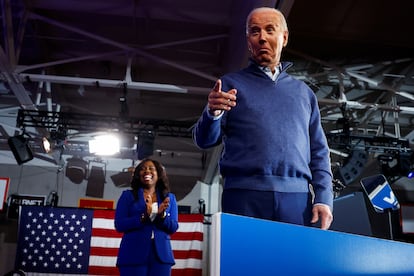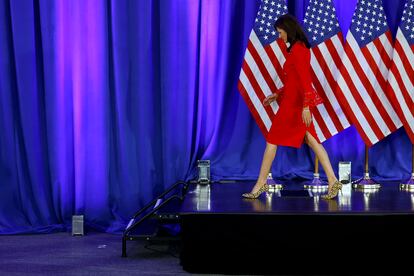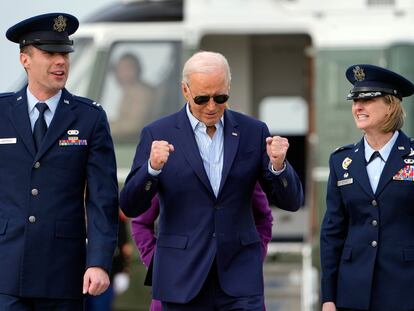Biden and Trump go on the hunt for the independents
They identify as neither Republicans nor Democrats and represent almost half of the electorate, a percentage that is growing steadily; in the November elections, they will be more crucial than ever


The withdrawal of Republican candidate Nikki Haley after the poor results of Super Tuesday marked the beginning of the independent voter hunting season, which will be fiercer than ever in the U.S. elections next November. Despite her refusal to endorse him, Haley also cleared the way for Donald Trump to be his party’s nominee in the race for the White House, which will lead him to face Joe Biden one more time.
After Haley’s resignation, both politicians threw themselves into the courtship of Haley’s supporters. It is a heterogeneous group, a mix of independents, old-fashioned Republicans and never Trumpers, the former president’s most intimate enemies. There are also moderate and college-educated voters, as well as suburbanites, which in this country is more a state of mind than a geographic location. Trump invited everyone to “join the greatest movement in the history of this country,” while Biden reminded them that there was room for them in his campaign.

Haley’s supporters helped her win two primaries (the District of Columbia and Vermont). In interviews with a dozen of them in South Carolina, they seemed united by the fear of a second round of Trump and by the desire for American conservatism to turn the page on the tycoon, who this Friday secured total control of the Republican National Committee (RNC), the governing body of the formation, by placing Michael Whatley, a man of his confidence, at the head (the operation was completed with the appointment of his daughter-in-law Lara Trump as co-chair). Now that he is the party’s candidate, the RNC will be able to contribute to the financing of his campaign. When asked what they planned to do without Haley, most of his supporters in South Carolina were undecided.
Before Super Tuesday, the candidate reaped her best results in that Southern state (40%) and in New Hampshire (42%), which share their status as open primary systems: one does not have to be a registered voter to participate in them, although its necessary to decide in which of the two, Republican or Democrat, one wants to contest. That is why they were two ideal laboratories to analyze the intentions of the always elusive independents. And what came out of those experiments was not good news for Trump, who has galvanized his bases, but these do not add up to enough to give him the White House.

The problems are also piling up on Biden’s side, whom the polls show as a loser eight months before the election. These problems stem from his support for Israel in the Gaza war, which angered young people and the Arab population and earned him a punishment vote in the primaries; from the feeling among the public that the economy is not doing as well as he claims; and from the disappointment of Black voters, who expected more from his promises. After passing the test of the State of the Union speech — which made the Democratic base breathe a sigh of relief and at times seemed more like a political rally —, the president has embarked since Friday on a week of electoral events in six decisive states, from Pennsylvania to Michigan, and from Georgia to Wisconsin.
His campaign, better financed at this point than that of his Republican opponent, is speeding up: he plans to open more than a hundred offices around the country in March and hire some 350 employees. It is urgent to turn around data such as the Times/Siena poll, which last week not only gave Trump as the winner, but also concluded that 83% of Biden’s voters in 2020 plan to support the president again, compared to 97% in the case of the tycoon.
The effect of polarization
“In a polarized time like this, we know that Republicans vote Republican; and Democrats, Democrat,” explains Arizona State University professor Thom Reilly in a phone interview. “That’s why the focus should be on those who define themselves as independents. If I was advising the parties, I would be hyper focused in asking independents what is going to drive them to go to the polls. In Trump’s case, it seems that if he’s found guilty in one of his four pending criminal cases that could be the determining factor in driving them away. It’s certainly the thousand-dollar question,” adds Reilly, who founded the “only center dedicated to the study of independent voters in the United States” — Center for an Independent and Sustainable Democracy — a couple of years ago, and in 2023 co-wrote The Independent Voter, the most comprehensive essay on the subject to date.
It looks like a field of study with a future. Since the late 1980s, Gallup has been calculating the evolution of the percentage of these independent voters in the U.S. system; last year it concluded that an all-time high of 43% had been reached. If they were to unite their wills, they would form the majority party in the United States. “That’s what is often said, but, beware, one of the most common mistakes is to consider them as a homogeneous bloc, situated in one part of the political spectrum, the center, for example,” warns Reilly. “The truth is that it is never quite like that; they are all over the place. Many are centrists, but there are also those at the extremes. Maybe the bell curve is a good way to look at it.”
In this election, several projects seek to resurrect the old dream of the creation of a third party. On the one hand, there are the candidacies of anti-vaccine politician Robert Kennedy Jr. and the possible carryover of his illustrious last name, and Black thinker Cornel West. And there is a centrist coalition called No Labels, which on Friday confirmed it was sticking with its plans to run a “unity ticket,” with a Republican candidate for president, and a Democrat as a vice presidential contender. Similar efforts have failed in the past. At best, they succeeded in hurting one side, and made good on a famous dictum by the American historian Richard Hofstadter (1916-1970): “Third parties are like bees. Once they have stung, they die.”
The growth of the independents cannot be understood without taking into account the weakening of the traditional political formations, whose pollsters, Reilly clarifies, often err in considering the undecideds won for good if in a certain election they decided to vote for them. “They don’t want to realize that it’s an unpredictable group. Nor that people are abandoning the parties in a pretty dramatic way,” the expert clarifies. “If you look at young people, Generation Z, the trend is even more pronounced. Between 60 and 65% identify themselves as independent. What’s more, they have never been part of a party, which they see as hyper-polarized, and many are disillusioned. They feel they are disenfranchised in the name of a binary system.”
Polls for the November elections have identified another group that can be decisive: they add up to 20% and are known as the “double haters,” because they hate both Trump and Biden. On the Democratic side, these polls certify the low enthusiasm among young people for the president and his military support for Israel. One of the big unknowns on election night will be to see how much they abstain. “Although that,” says Reilly, “doesn’t necessarily make them politically disengaged, which is another of the misconceptions about independents.”
It is simply another way of getting involved, different from that of the Baby Boom generation, whose political history in this country flowed naturally through their partisan identification. Historian Michael Kazin belongs to that old school: he has been associated since the 1960s, with its comings and goings, with the Democratic Party, to which he dedicated What It Took to Win, a sort of biography of a bicentennial political formation, which in reality is an amalgam of interests that are not always well-matched, as is now becoming clear.
The genuine and the inclined
Kazin believes, with other analysts, that only a minority of independents are truly independent. “Most vote pretty consistently for one party’s candidates or the others’ but don’t want to self identify as partisans at a time when so many Americans dislike what they take to be an unprincipled struggle for power between the Democrats and Republicans,” he explains in an email.
That genuine minority is usually between 10% and 13% of the electorate, but Reilly finds that figure “dismissive” because he believes it is distorted by another category of voters, the “leaners.” These are independents who, after declaring themselves as such, answer the second pollster’s question about which party they feel more inclined to by choosing one of the two. “If you look at the data over time, you’ll see that they initially supported Obama and his candidacy by eight percentage points [in 2012] . When Trump ran the independents supported him by four percentage points. Then [in 2020] they jump back to Biden by 13 percentage points. That shows that they are very unpredictable in their voting patterns,” he adds.
When asked if he observes such disaffection from young people among his students at Georgetown in Washington, Kazin replies that he makes it a rule not to ask them who they vote for. “But Georgetown is a liberal school in a liberal city (and area), and few students identify as conservative. I’m quite sure a large majority vote for Democrats ―if they vote. But the chapters of the Young Democrats and Young Republicans are fairly small and in DC, and one would expect at least the Democratic one to be larger, since politics is always in the air [in Washington]” This last Saturday, on a rainy morning, not a single student was to be found on campus who was a registered voter, and a few who were unmotivated to go to the polls in November.
Colin Seeberger, senior advisor to the Washington-based progressive think tank Center for American Progress Action Fund, believes this also has to do with the discrediting of institutions, “not just political ones.” “Young people don’t want to be pigeonholed into any particular group, where they feel they wouldn’t have an easy time forming their own opinions and expressing them,” he says.
And which side does Seeberger think independents will fall on during the campaign? “It’s too early to tell, but Trump has made it very clear that he’s not interested in having the support of anyone who disagrees with him. Everything has to be 100% MAGA [as in his Make America Great Again slogan],” he responds, before citing four recent polls that give Biden a lead among independents (the largest of all is the one given to him by the Fox News poll: nine points). In his opinion, that is because, as was seen in the 2018, 2020, 2022 and 2023 elections, “Trump’s magaextremism ends up being unpopular.”
For his part, César Martínez, a strategist specializing in the Latino vote who worked in four presidential elections with Republican candidates and who in 2020 did so against Trump, agrees with Seeberger that the tycoon “is making his campaign tent smaller and smaller, exclusive,” and that it will be interesting to see how the Hispanic electorate behaves, which is “the minority that tends to oscillate the most between both parties.” “That’s what gives them their strength,” Martínez considers.
To venture what lies ahead until November, the strategist resorts to a movie simile. “Remember that movie, Grumpy Old Men [1993]? In that movie, Walter Matthau and Jack Lemmon were vying for Ann-Margret’s attention. Well, this campaign will be like a sequel to that story, with two 80-year-old white guys fighting for America. Neither can sell a future,” he says. Within that analogy, independents would be that part of the audience that attends the film “quietly,” “watching and analyzing,” and who will know who they are voting for when they leave the theater on November 5, election day. The only sure thing is that, whatever they decide, it will give the presidency to one “grumpy old man” or the other.
Sign up for our weekly newsletter to get more English-language news coverage from EL PAÍS USA Edition
Tu suscripción se está usando en otro dispositivo
¿Quieres añadir otro usuario a tu suscripción?
Si continúas leyendo en este dispositivo, no se podrá leer en el otro.
FlechaTu suscripción se está usando en otro dispositivo y solo puedes acceder a EL PAÍS desde un dispositivo a la vez.
Si quieres compartir tu cuenta, cambia tu suscripción a la modalidad Premium, así podrás añadir otro usuario. Cada uno accederá con su propia cuenta de email, lo que os permitirá personalizar vuestra experiencia en EL PAÍS.
¿Tienes una suscripción de empresa? Accede aquí para contratar más cuentas.
En el caso de no saber quién está usando tu cuenta, te recomendamos cambiar tu contraseña aquí.
Si decides continuar compartiendo tu cuenta, este mensaje se mostrará en tu dispositivo y en el de la otra persona que está usando tu cuenta de forma indefinida, afectando a tu experiencia de lectura. Puedes consultar aquí los términos y condiciones de la suscripción digital.










































